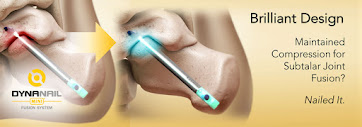What is Subtalar Fusion?
Subtalar fusion is a type of surgical procedure performed to relieve pain and correct deformities in the hindfoot often affected by injury, arthritis, or genetic defect. Subtalar fusion involves fusing the calcaneus to the talus.
The inferior tibiofibular joint is
where the fibula meets the shin bone, and the subtalar joint is where the calcaneus
(i.e. heel bone) meets the talus bone. Subtalar fusion is sometimes performed
arthroscopically to relieve foot pain
and reduce the amount of surgical exposure. Make sure to discuss with a
reliable surgeon to know which method would be suitable for you.
1. Open surgical
procedure
Open surgery for subtalar fusion is generally performed
under general anesthetic and takes about ninety minutes. The surgeon will first
make an incision on the outside of the ankle. Then, they will clean the joint
surface and fix the joints together via one or two screws by implanting them
through the back of the heel. The screws are placed not to be removed. The post-surgery
protocol involves applying a cast to the foot, and sometimes a small tube
attached to the wound to drain out excess fluid.
2. Arthroscopic surgical
procedure
This procedure relieves foot pain in a less invasive
way that allows for less pain, swelling, and disability after the surgery. The
surgeon makes two to three small incisions through which the surgeon inserts
the camera and instruments to view the joint. Fluid is flushed into the joint
to make the surgery easier. Motorized shavers, biters, and graspers are used to
make corrections in the subtalar joint.
3. Cartilage removal
technique
As part of a subtalar fusion surgery, all the
cartilage is removed to prepare the joint surface for fusion. The surgeon
roughens the bone surface to stimulate bleeding, which enables the two bones to
heal together right after the joints are fixed together with screws.
4. Using DynaNail Mini®
DynaNail Mini®
is an orthopedic device made of nickel-titanium that maintains active
compression after surgery. It is essential to have compression over the joint
to ensure that the bones are tightly apposed and to promote adequate bone
healing. The elastic properties of nickel-titanium allow the DynaNail Mini®
to automatically adapt and respond to any
joint changes during the healing process.
It’s a better alternative to the traditional use of screws in subtalar
fusion open procedures.
Subtalar fusion has many successful
cases with good recovery, so the patients can return to doing rigorous
activities. You can contact MedShape
Inc. to learn more about techniques for
subtalar fusion using unique compression sustaining technology.




Comments
Post a Comment